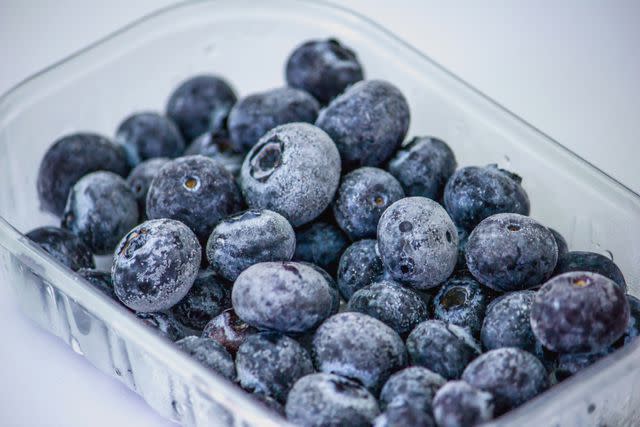How to Freeze Blueberries For Smoothies, Pies, Pancakes, and More
Our Test Kitchen swears by this easy clump-free strategy to preserve berries for sweet and savory uses.
Whether we’re sourcing fresh blueberries from the farmers market, a pick-your-own farm, or the supermarket, it’s tough to accurately estimate exactly how many fresh berries to invest in for our favorite healthy blueberry recipes…and the handfuls of snacks we’ll snag during the drive home, to refuel midafternoon, or to power us up while we’re cooking those aforementioned recipes.
If you, too, tend to overestimate how many berries you’ll be able to get through before they’re at-risk for getting past their prime, there’s a simple solution just inches away from the refrigerator where you’re storing your berries: your freezer.
Read on to learn exactly how to freeze fresh blueberries to preserve their sweet-tart flavor and antioxidants to enjoy for months to come. Sarah Brekke, M.S., Better Homes & Gardens Test Kitchen culinary specialist, will coach you through the flash-freezing process, then we’re spilling about the best ways to use those versatile violet beauties.

Kanawa_Studio / Getty Images
How to Freeze Blueberries
As you prepare to follow our guide to how to freeze blueberries, you’ll need just a few tools:
Rimmed baking sheets that fit within your freezer to hold the berries as they freeze.
Parchment paper to line those baking sheets.
A freezer-safe storage vessel, such as a zip-top bag or airtight container.
A permanent marker to write the name and date on the exterior of the package.
Optional:
A colander if you opt to rinse the berries.
A clean kitchen towel, to dry the rinsed berries before freezing.
It’s a breeze to master how to freeze blueberries:
Sort through the fresh blueberries, extracting any twigs, leaves, stems, or debris.
Scatter the blueberries in a single layer on a parchment paper-lined rimmed baking sheet (or multiple, if needed, to allow the berries enough room to remain on on a single layer).
Place the baking sheet(s) in the freezer, and allow the berries to freeze until solid, or for about 1 to 2 hours.
Transfer the frozen berries to a freezer-safe container, then use a marker to label and date the frozen blueberries.
Frozen berries and blueberry puree can be frozen for up to 10 months, but they’re best within the first 6 months.
Test Kitchen Tip: If you’d rather freeze a blueberry purée to defrost later to use in sauces, smoothies, and desserts, in a medium saucepan over medium heat, add 1 cup of sugar for every 2 quarts of crushed blueberries. Stir until the sugar is dissolved. Allow this blend to cool, then transfer the mixture to zip-top freezer bags or freezer-safe containers. Label and date, then freeze for up to 6 months. Thaw in the refrigerator overnight before using.
Related: 33 Fruits and Veggies You Should Refrigerate and 7 You Shouldn’t
Should You Wash Blueberries Before Freezing Them?
To wash or not to wash? The internet is ripe with debate over this topic. Depending on who you ask about how to freeze fresh blueberries, you’ll get a different answer.
According to the U.S. Highbush Blueberry Council, “ideally, freeze your blueberries as they are and wait to rinse them when you take them out of the freezer.”
This is because fresh blueberries are coated in a natural white/gray “bloom,” or epicuticular wax, which protects the fruit from extreme temperatures, dehydration, as well as spoilage by way of mold and bacteria. Rinsing the berries will wash off that natural “armor,” so if possible, store the berries in their au naturel glory.
If you do opt to rinse the fruit as step one of your process for how to freeze blueberries, do so in that colander we mentioned, and be sure to dry them thoroughly with the clean kitchen towel before arranging them on the parchment-lined baking sheet(s).
“If the berries are still wet when freezing, they will likely clump together and are more prone to becoming freezer burnt,” Brekke says. (Plus, extra moisture can increase the risk for the growth of bacteria and mold.)
What to Do With Frozen Blueberries
Ready to put those frozen blueberries to good use? If you didn’t wash them before freezing, use a colander to give the berries a good rinse under cool running water. Dry the fruit with a clean kitchen towel and proceed with your favorite blueberry recipe. In most cases, you don’t even need to thaw the berries before diving in to recipe prep
“Most recipes will work fine with frozen fruit. Smoothies, quick breads, pancakes, pies, and crisps all work wonderfully with frozen blueberries,” Brekke says.
That being said, you can thaw them if you like. To do so, place the frozen berries in a large bowl, then cover with cool water and wait 30 minutes. Drain and use as desired. Alternatively, transfer your desired quantity of frozen blueberries to the refrigerator, and allow them to defrost for 6 hours or overnight.
As we mentioned, this is one highly adaptable fruit. Beyond Brekke’s recs, we adore frozen berries in barbecue sauce and blueberry ketchup (yes, really!). The U.S. Highbush Blueberry Council suggests adding frozen blueberries to sauces, compotes, jams, chutneys, French toast, and baked desserts (such as muffins, scones, pastries, and cakes)—or simply enjoy them as-is for an ice pop alternative with zero added sugar.
For more Better Homes & Gardens news, make sure to sign up for our newsletter!
Read the original article on Better Homes & Gardens.

